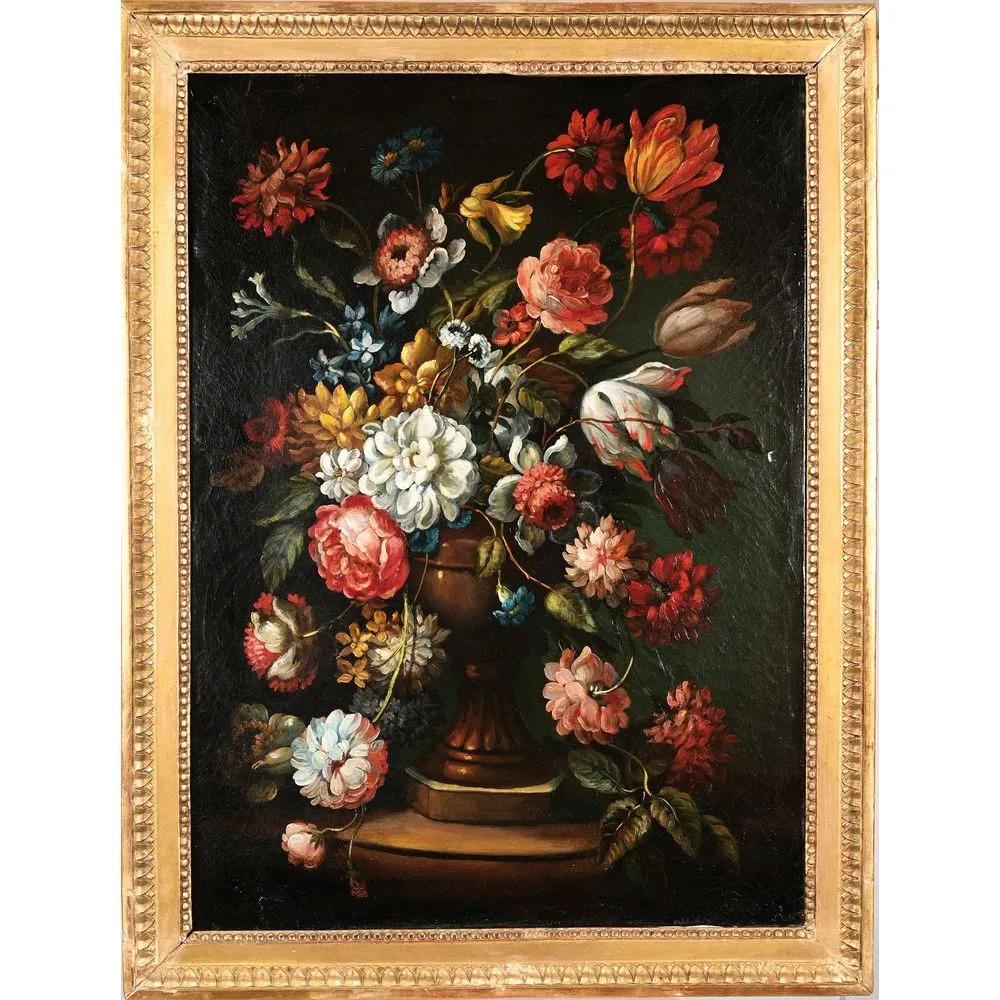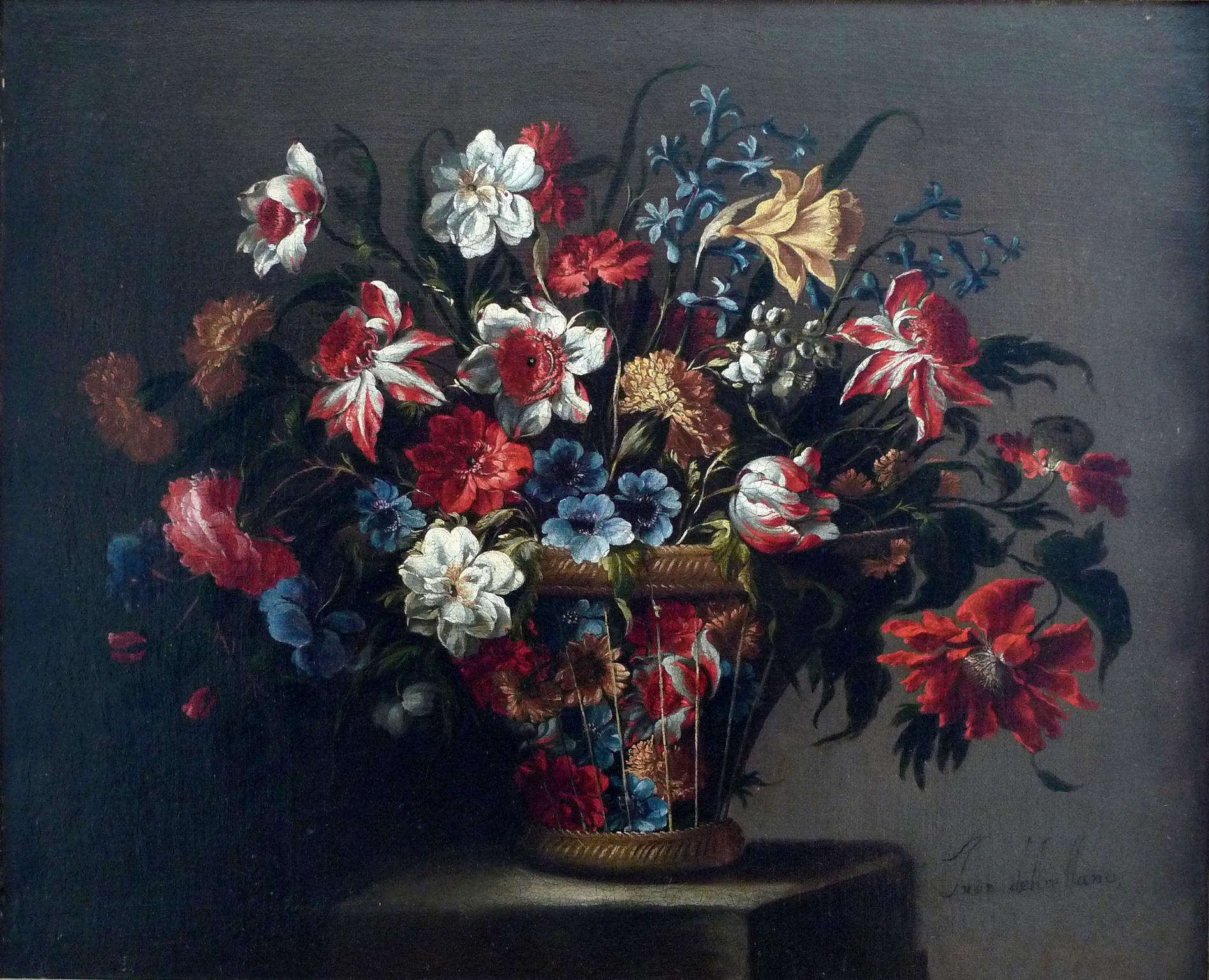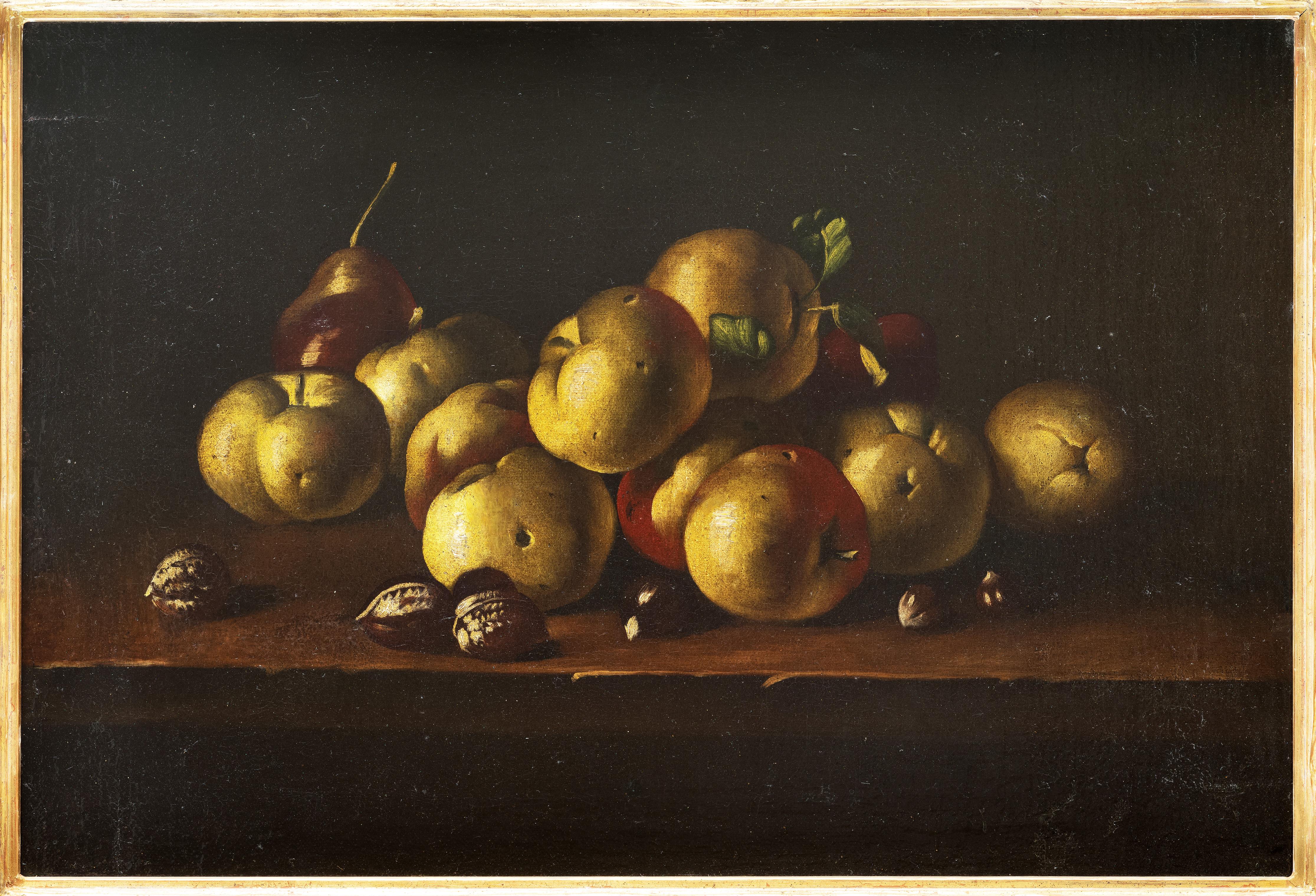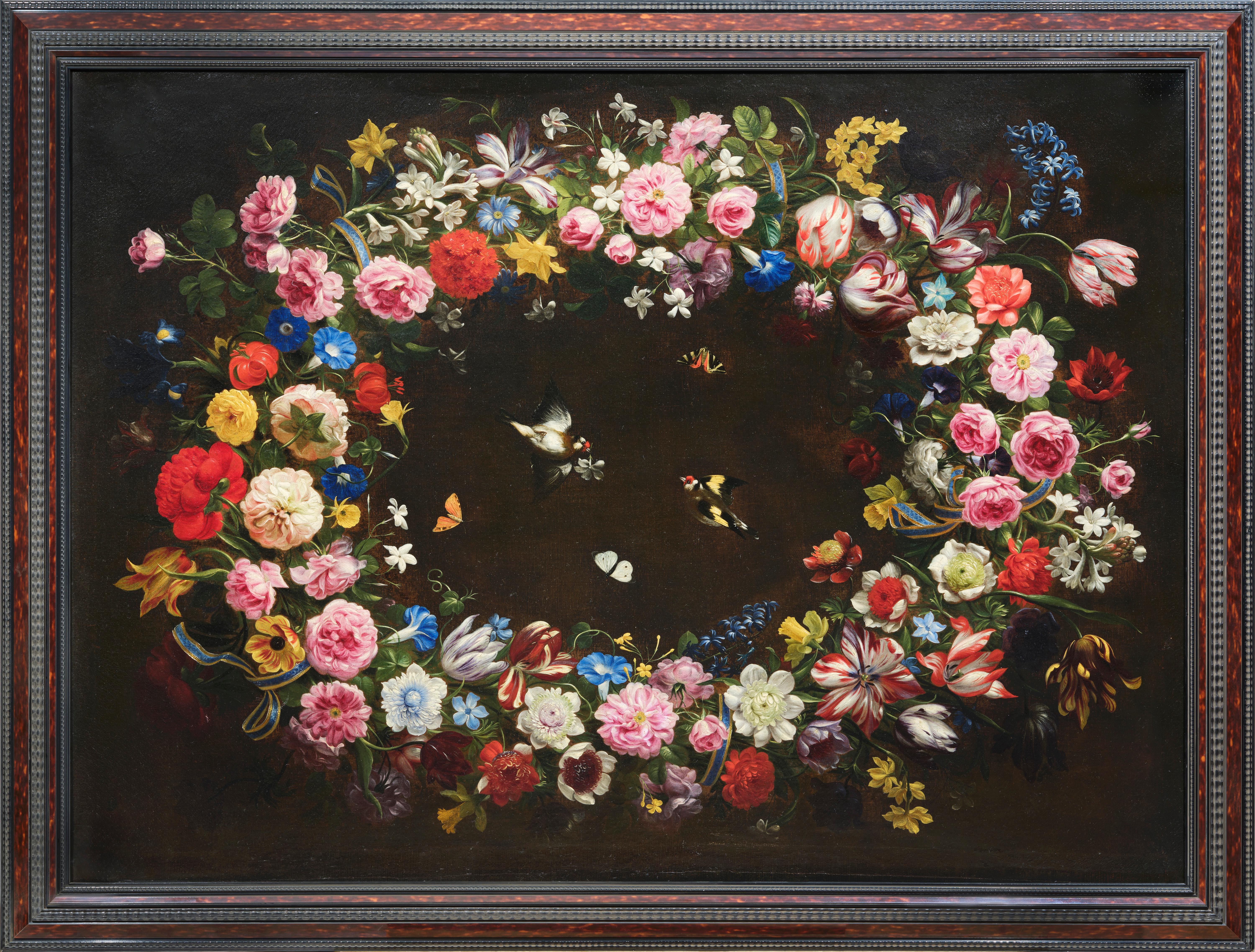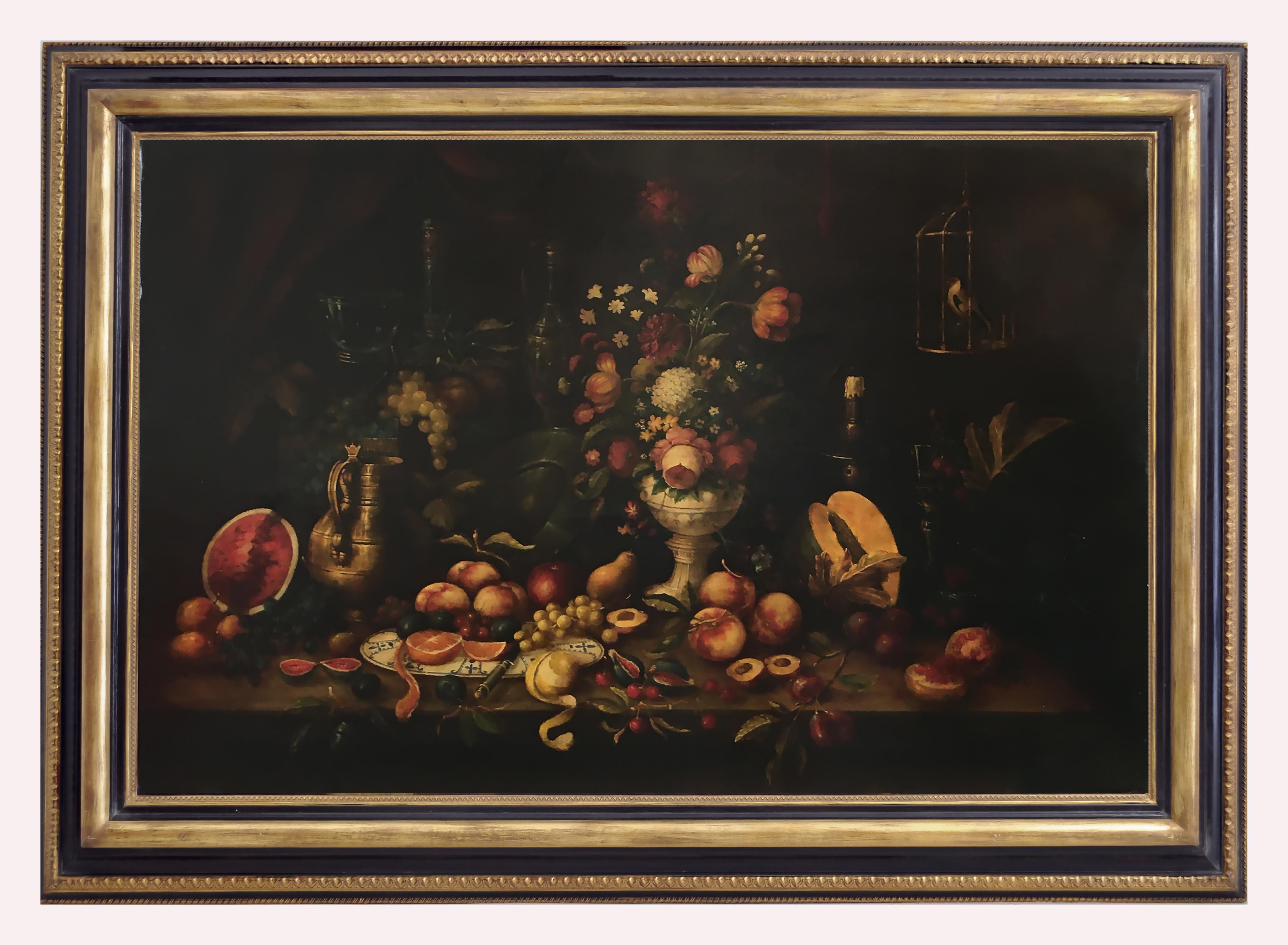Items Similar to Pair of Large Floral Still Lifes in the Old Master Style
Want more images or videos?
Request additional images or videos from the seller
1 of 13
UnknownPair of Large Floral Still Lifes in the Old Master Style Early 20th century
Early 20th century
About the Item
Pair of large floral still lifes in the Old Master style
Continental, Early 20th Century
Canvas: Height 120cm, width 90cm
Frame: Height 141cm, width 111cm, depth 6cm
This pair of beautiful floral still-life paintings recall the style of the Dutch Old Masters, who rendered realistic still-life scenes filled with fruit, flowers, and foliage against dark backdrops. Depicted from a low vantage point, each painting is dominated by a large vase copiously filled with a variety of blooms. Rendered in vibrant pastel shades, the flowers appear to take over the canvas, even spilling onto the ground below in a display of abundance. In between the bright petals, dark green foliage peeks through, and the minute water droplets that trickle down the leaves indicate the painterly skills of the artist.
The flowers each sit inside a large urn that is decorated in a classical style. The first is adorned with swags which meet in small cherub heads, whilst the other has a more scrolling design that evokes acanthus leaves. The plain yet shaded backdrops allow the viewer to focus on the lavish floral subject at hand, as well as adding a sense of timelessness to these refined works.
Both works are set in carved giltwood and ebonised wood frames, which complement the colour palette of the paintings.
Harking back to a golden age of painting history, these magnificent still lifes brim with floral beauty.
- Creation Year:Early 20th century
- Dimensions:Height: 55.52 in (141 cm)Width: 43.71 in (111 cm)Depth: 2.37 in (6 cm)
- Medium:
- Movement & Style:
- Period:
- Condition:
- Gallery Location:London, GB
- Reference Number:
About the Seller
5.0
Vetted Seller
These experienced sellers undergo a comprehensive evaluation by our team of in-house experts.
1stDibs seller since 2017
24 sales on 1stDibs
Typical response time: 1 hour
- ShippingRetrieving quote...Ships From: London, United Kingdom
- Return PolicyA return for this item may be initiated within 14 days of delivery.
More From This SellerView All
- Still life painting of fruit in a basketLocated in London, GBStill life painting of fruit in a basket Continental, c. 1800 Frame: Height 81cm, width 91cm, depth 7cm Canvas: Height 57cm, width 69cm, ...Category
Late 18th Century Old Masters Still-life Paintings
MaterialsCanvas, Oil
- Antique Still Life of Flowers by W. J. WainwrightLocated in London, GBAntique still life of flowers by W. J. Wainwright English, Late 19th Century Canvas: Height 127cm, width 101cm Frame: Height 144cm, wi...Category
Late 19th Century Still-life Paintings
MaterialsWood, Oil, Canvas
- Large Spanish Painting of Flowers by Manuel de la RosaLocated in London, GBLarge Spanish painting of flowers by Manuel de la Rosa Spanish, Late 19th Century Frame: Height 146cm, width 67cm, depth 7cm Canvas: Height 126cm, width 46cm Painted by Manuel de l...Category
Early 20th Century Naturalistic Still-life Paintings
MaterialsCanvas, Oil
- Still life painting of fruit and flowers by Eugène BoudinBy Eugène Louis BoudinLocated in London, GBStill life painting of fruit and flowers by Eugène Boudin French, 1869 Canvas: Height 90cm, width 80cm This very fine still life painting is by the Fren...Category
1860s Impressionist Still-life Paintings
MaterialsCanvas, Oil
- Still life painting of fruit and a parrot by French artist Eugène BoudinBy Eugène Louis BoudinLocated in London, GBStill life painting of fruit and a parrot by French artist Eugène Boudin French, 1869 Canvas: Height 90cm, width 80cm This very fine still life painting is by the French artist Eugè...Category
1860s Impressionist Still-life Paintings
MaterialsCanvas, Oil
- Still life of flowers and fruit by Joseph Panneel, (Belgian, 1807-1848)Located in London, GBStill life of flowers and fruit by Joseph Panneel, (Belgian, 1807-1848) Belgian, 1844 Frame: height 93cm, width 83cm, depth 7cm Canvas: height 73cm, width 61cm, depth 2cm Working in...Category
1840s Still-life Paintings
MaterialsCanvas, Oil
You May Also Like
- École flamande du XVIIIe sLocated in ROUEN, FRSuiveur De Cornelis De Heem (1631-1695) Bouquet de fleurs dans un vase, huile sur toile. 69x56,5 cmCategory
18th Century Old Masters Still-life Paintings
MaterialsCanvas, Oil
- "Cesta de flores", 17th Century Oil on Canvas, Still Flowers by Juan de ArellanoBy Juan de ArellanoLocated in Madrid, ESJUAN DE ARELLANO Spanish, 1614 - 1676 Cesta de Flores signed Juan de Arellano (lower lright) oil on canvas original period carved, gilt and polychrome...Category
17th Century Old Masters Still-life Paintings
MaterialsCanvas, Oil
- A gentleman’s vicesLocated in London, GBEnglish School, circa 1827 A gentleman’s vices the newspaper dated ‘Sunday December 23 1827’ (upper left) oil on canvas 20 ¾ x 24 ½ in. (52.7 x 62.3 cm.) frame 25 ⅝ x 29 ¼ in. (65.1...Category
Early 19th Century Old Masters Still-life Paintings
MaterialsCanvas, Oil
- Still Life with Apples and Nuts, 17th Century, Old Master, Spanish PaintingLocated in Greven, DEJuan Sánchez Cotán (1560 - 1627) was one of the most important still life painters in Spain and beyond. He developed a certain type of still life with a ...Category
17th Century Old Masters Still-life Paintings
MaterialsCanvas, Oil
- Flower Garland by Giovanni Stanchi, the most Flemish Italian flower painterBy Giovanni StanchiLocated in PARIS, FRThis painting is reproduced in the reference book on Roman still life "Pittori di nature morta a Roma - artisti italiani 1630 -1750" by Gianluca and Ulisse Bocchi - Arti Grafiche Castello 2005 (page 250 figure FS5), where it is mentioned as one of the few paintings that can be given with certainty to Giovanni Stanchi. This highly decorative flower garland reveals a very strong Flemish influence, enabling us to attribute it with certainty to Giovanni Stanchi, the eldest of a sibling group of painters active in the production of still lifes in 17th century Rome. Probably painted before 1640, our garland conceals a mystical message beneath its decorative opulence, which we're about to reveal ... 1. Giovanni, Niccolò and Angelo Stanchi, a brotherhood of still-life painters in 17th-century Baroque Rome The three Stanchi brothers, Giovanni (1608 - after 1675), Niccolò (ca. 1623 - 1690) and Angelo (1626 - after 1675) lived and worked together (like the Le Nain brothers), making identification of the different hands perilous. Giovanni Stanchi's name is first mentioned in 1634, in the register of the painters' guild of the "Accademia di San Luca". Paid membership of the painters' guild provided not only a social network, but also commissions from important Roman families. In 1638, Giovanni Stanchi painted a picture for the Barberini family depicting their coat of arms surrounded by flowers. In 1660, he was commissioned by Cardinal Flavio Chigi to decorate a gallery with still lifes of flowers and fruit. The Chigis remained his principal patrons until after 1673. Thereafter, he received commissions from almost every important family in Rome. An invoice dated 1670 identifies Giovanni Stanchi and Mario Nuzzi as the painters responsible for the still lifes that decorated the famous mirrors in Palazzo Colonna. In 1675, Giovanni Stanchi's name appears for the last time in connection with a project in which he was engaged, together with Andries Bosman and the figure painter Ciro Ferri, to decorate the mirrors of the Palazzo Borghese on Campo Marzio. Although all three brothers were active as painters, the records of their commissions always refer to Giovanni, since, as eldest brother, he was responsible for invoices and contracts. Only in a few cases is the name of one of the younger brothers mentioned. Only paintings with a strong Flemish influence dating from the first four decades of the 17th century, such as this one, can be attributed with certainty to Giovanni, as he was the only painter in the family at the time. 2. History of a genre: the flower garland Jan Brueghel the Elder (Brussels 1568 - Antwerp 1625) is credited with inventing the flower garland theme during his stay in Rome in 1592. Such garlands were originally used to surround a religious subject, often a Marian one. This religious scene could sometimes be painted by another artist, as in the painting acquired in 1608 by Cardinal Borromeo, featuring a Madonna (painted by Henry van Balen), surrounded by a garland painted by Jan Brueghel. This theme was taken up and developed in Rome from 1625 onwards by Daniel Seghers, before the young Giovanni Stanchi made it his own, reinforcing its symbolic dimension (to which we shall return) and moving away from the naturalistic approach of Jan Brueghel to develop a certain idealization of each flower, closer to the style of Mario Nuzzi (Rome 1603 - 1673). Giovanni Stanchi's garlands, of which he was the best Italian interpreter in the 17th century, also reveal him to be one of the most faithful to the Flemish tradition. The book by Gianluca and Ulisse Bocchi lists nine still lifes very similar to ours, all executed on a black background (including the one reproduced as the last photo in the gallery, which belongs to the Pinacoteca Nazionale in Bologna). Because of their proximity to Flemish works, they can be attributed with certainty to Giovanni Stanchi. Four of them belong to private collections, while the others are all in public institutions (Anhaltische Gemäldegalerie, Dessau; Galeria del Palazzo Bianco, Genoa; Musée des Beaux-Arts, Bordeaux; Pinacoteca Nazionale, Bologna; Palazzo Chigi-Saraceni, Siena). Like those in Flemish still lifes, the flowers depicted by Giovanni Stanchi bloom at different times of the year, ruling out any representation of a real bouquet. Alongside the more traditional flowers of our gardens (roses, tulips, hyacinths, daffodils, irises), it is also interesting to note the frequent inclusion of more exotic flowers such as jasmine and blue bindweed (ipomoea indica), which had been recently introduced to Europe from Mexico. Each flower painted by Giovanni Stanchi seems to have its own individuality, a trait characteristic of Flemish painting, of which Stanchi was the best interpreter in Italy. One could say that Stanchi does not depict garlands of flowers, but flowers in a garland, each with its own identity and specificity, making it unique and different from the others. Captured in a low-angled light that seems to have captured them for eternity, they are drawn with clear, precise lines. As if they had been freshly cut, they emerge from the darkness in geometric figures that reinforce the tactile quality of their representation. One of Giovanni Stanchi's distinctive features is to have substituted the central religious representation traditionally associated with Flemish flower...Category
17th Century Old Masters Still-life Paintings
MaterialsCanvas, Oil
- Still Life - Italian Oil On Canvas Painting by Antonio JannoneBy ANTONIO JANNONELocated in Napoli, ITStill life - Oil on canvas cm.100x150, Antonio Jannone, Italy, 2003. Frame available on request.Category
Early 2000s Old Masters Still-life Paintings
MaterialsCanvas, Oil
Recently Viewed
View AllMore Ways To Browse
Floral Beauty
Old Style Antique
Old Weller Antique
Old Wellers Antique
Unknown Master
Large Old Wood
Large Floral Still Life
Carved Wood Life
Large Antique Style Frames
Still Life Pair
Pair Of Still Life
Display Old Wood
Old Green Antique
Large Antique Still Life
Dutch Old Masters
Pair Large Paintings
Large Scroll Art
Still Life Floral Antique
